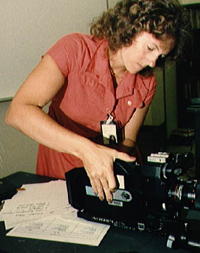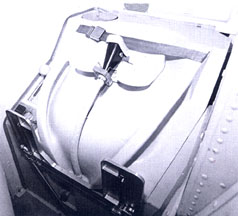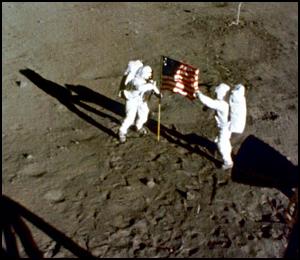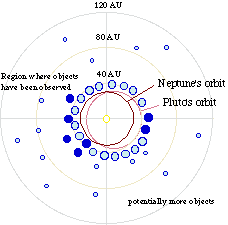Click on image for full size
Image courtesy of NASA
Related links:
What Role Have Women Played in the History of the Space Program
*Please note that this page is a student project written by Nicole Turner. It was not written or edited by Windows to the Universe scientists.*
From Harriet Quimby (the first licensed woman pilot,) to Amelia Earheart (the first woman to fly across the Atlantic Ocean,) one way women started to explore space was through aviation. Between these two remarkable women were many others who fought to achieve their hopes and dreams to become aviators. Yet these women went pretty much unnoticed, they played an important roll in the history of the space program. Some of these notables are Bessie Coleman (the first African-American woman pilot,) and Phebe Farigrave Omelie (the first woman transport pilot, and was appointed as Special Assistant for Air Intelligence of the National Advisory committee for Aeronautics, a forerunner of NASA.)In 1961, the Mercury 13 women aviators were secretly, and extensively tested for their physical and psychological tolerance to the then-unknown rigors of spaceflight. The first women to go through the Mercury 13 astronaut test was Jerrie Cobb. A 28-year-old pilot, with three world records, and 7,000 hours of flying time, Jerrie Cobb had ice water injected into her ears to test her balance. This was just one of the strange tests made to test women. She, as well as Wally Funk, were the only women who successfully completed the tests used for the original seven Mercury astronauts. In spite of these women completing all three of the phases, and 11 other women completing Phase I, they would never get the chance to go into orbit. NASA refused to authorize the successful completion of these tests for fear that the public might take it as approval fo women to be "astranettes" (the female version of an astronaut.)
Through testimonies before House Space subcommittees in the 1960's, and years of more thorough testing, NASA placed the first woman in space, Dr. Sally Ride. June 8-16, 1983, Sally became the first American woman in space, and the first woman to deploy and retrieve a payload on the Shuttle using the remote manipulator arm. Sally was the breaking off point for NASA. Although mostly dominated by men, a few more women began to pop up here and there in the science fields. This was a grand slam for women in the playing field of space exploration with NASA.
Dr. Anna Fisher was one of the women who had a chance through Sally Ride's amazing struggle. November 8-16, 1984, Anna became the first person to retrieve a malfunctioning satellite with the remote manipulator arm. This became the first "salvage" mission. Dr. Rhea Seddon became the first to try a satellite repair out of the earth's atmosphere with the remote manipulator arm. She designed a makeshift "fly swatter" contraption space walkers attach to their arm. Rhea used the arm to grab a lever on the malfunctioning craft. She loggged over 720 hours in space on three missions. April 12-19, 1985, Dr. Kathryn Sullivan proved to us that it is possible to refuel a satellite during a spacewalk. In November 1985, Dr. Bonnie Dunbar, running a group of four missions, and logging 1,000 hours, worked with the crew of STS-61A to conduct the first comprehensive series of materials-precessing experiments in space. May 4-8, 1989, Dr. Mary Cleave became the first person to deploy a planetary probe from the Shuttle.
Dr. Tamara Jernigan was the payload commander on the first Shuttle flight dedicated in its entirety to investigating how the body adapts to micro-gravity. Dr. Mae Jemison became the first African-American woman in space in September 1992. April 8-17, 1993, Dr. Ellen Ochoa became the first Hispanic woman in space. Skipping right along, we come to Shannon Lucid, one of the first six women to graduate from the NASA Space Program for Astronauts. She was the second astronaut ever, and the first woman to serve as a Mir crew member. In 1996, she established a new American record for the longest time spent in space. She remained aboard Mir, when the rest of her STS-76 crew returned home aboard the Shuttle. (She beat the men on this one!)
Most women that wanted to go into the space field had many difficult times getting through school. Wanting to go into the space field, they had to take higher math classes, engineering, and higher science classes. The classes were often classified as "boy fields." Girls were not encouraged to take these classes. Their teachers, friends, principals, and even some parents criticized them about taking the "boy classes." They were treated unfairly, and not given the same opportunities, and respect as the boys were. I can easily relate to some of the diffuculties, and I am only going in to the sixth grade.
What roles have women played in the history of the space program? I hope this essay has contributed to your understanding, and ideas about women in space. During their struggle, many women lost their determintaiton, and will to go into a "man's world," and a "man's field." These women helped future generations to see that these occupations can be successfully held by women. A special thank you goes out to those women who tried to make it in science fields, but could not, and to those who tried, and did. Thank you for helping pave the road for future generations of women to explore space! Their history, is our future!













